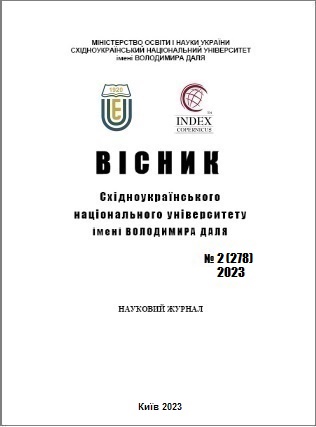Intellectual potential management system based on branding tools
DOI:
https://doi.org/10.33216/1998-7927-2023-278-2-90-95Keywords:
brand, brand management, intellectual capital, human capital, enterprise management systemAbstract
The presented work examines the main features of the formation of the intellectual potential management system of the enterprise for the purpose of using branding tools. The main features of the branding toolkit and its use in the context of globalization and innovative changes are also defined. The purpose of the presented work is to determine the main components of the intellectual potential management system and the possibility of introducing branding tools for its further development. It was determined that effective communication is a key element of managing the intellectual potential of the enterprise. This includes developing messages, stories and messages that convey the values, benefits and uniqueness of the enterprise brand. Communication should be directed at various stakeholders, including customers, employees, partners and other interested groups.
Effective management of the enterprise's intellectual potential involves creating a unique brand experience for customers and employees. This may include personalized services, innovative solutions, high quality products and services that make the enterprise recognized and attractive to customers.
Intellectual property, such as patents, copyrights, and trademarks, is an important business asset. Its effective management, including protection, licensing and use, helps maintain competitive advantage and ensures brand sustainability.
The intellectual potential of the enterprise includes its employees. Attracting and retaining talented employees, as well as their development and stimulation, are important factors in the management of intellectual potential. Company branding can affect the attractiveness of the employer and the level of employee satisfaction.
A successful management system of the enterprise's intellectual potential should include constant monitoring and updating of the brand. This means taking into account changes in the market environment, customer needs and other factors that can affect brand perception and value.
The use of these features of the branding toolkit in the intellectual potential management system of the enterprise helps to create a strong brand that contributes to the positive perception of the enterprise, customer attraction and business development.
References
1. Arefiev S., Shevchenko I., Savkiv U., Hovsieiev D., Tsizhma Y. Management of the global competitiveness of companies in the field of electronic commerce in the conditions of digitalization. Journal of Theoretical and Applied Information Technology. Vol. 101(4) pp. 1527-1537. 2023 URL: http://www.jatit.org/volumes/Vol101No4/31Vol101No4.pdf
2. Faruk M., Rahman M., Hasan S. How Digital Marketing Evolved Over Time: A Bibliometric Analysis on Scopus Database. 2021. (Scopus). URL: https://www.researchgate.net/publication/357037311_How_Digital_Marketing_Evolved_Over_Time_A_Bibliometric_Analysis_on_Scopus_Database
3. Khavrova K.S. Definition of modern approaches to management of innovative development of the enterprise. [Визначення сучасних підходів до управління інноваційним розвитком підприємства] Intellect XXI. Vol. 4. 2019. URL: http://elibrary.donnuet.edu.ua/1781/1/Khavrova_article_2019_4.pdf
4. Rosyihuddin M. Analysis of New Terms in Digital Marketing Innovation Research Themes: Bibliometric Analysis. Indonesian Journal of Business Analytics (IJBA). Vol.3(2), pp.409-422. 2023. (Scopus). URL: https://journal.formosapublisher.org/index.php/ijba/article/download/3341/3610
5. Божкова В. В. Трансформації інструментарію маркетингових комунікацій в умовах глобалізації / В.В. Божкова, О.В. Птащенко, Л. Ю. Сагер, Л. О. Сигида // Маркетинг і менеджмент інновацій, 2018, № 1 – С. 73-82 (електронна версія Режим доступу: http://mmi.fem.sumdu.edu.ua/
6. Іванова Н. С. Оцінка рейтингу видів економічної діяльності методом таксономічного аналізу. Ефективна економіка № 12, 2016 URL : http://www.economy.nayka.com.ua/?op=1&z=5324
7. Кожушко О. Використання методу таксономії для оцінки рівня захисту інтелектуального капіталу промислових підприємств / О. Кожушко // Економічний аналіз. – 2010. – № 7. – С. 286–289.
8. Резнікова Н. В., Рубцова М. Ю., Рилач Н. М. Інституційні важелі міжнародної конкурентоспроможності національної інноваційної системи : проблема вибору інструментів стимулювання інноваційних підприємств // Ефективна економіка. 2018. № 11. URL : http://www.economy.nayka.com.ua/pdf/11_2018/16.pdf.
9. Сохацька О. М. Ефективність цифрових маркетингових комунікацій: від постановки мети до оцінювання результату // Олег Андрійович Легкий, Олена Миколаївна Сохацька // Маркетинг і цифрові технології. – 2017. – Т. 1. – № 2. – С. 4–31.
10. Стратегія ефективного брендингу: монографія / О. В. Кендюхов, С. М. Дмитрова, Л. А. Радкевич, О. В. Кужилева – Донецьк: Вид. «Вебер» (Донецька філія,) 2009 – 280 с.

